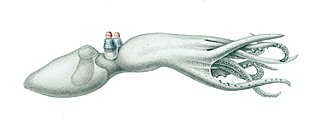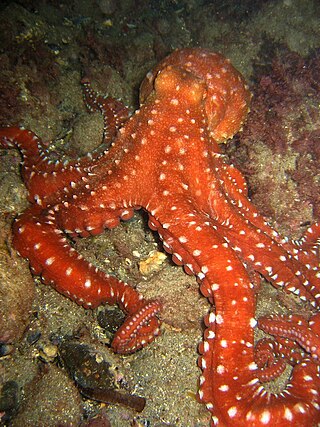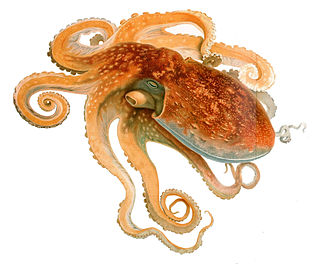
An octopus is a soft-bodied, eight-limbed mollusc of the order Octopoda. The order consists of some 300 species and is grouped within the class Cephalopoda with squids, cuttlefish, and nautiloids. Like other cephalopods, an octopus is bilaterally symmetric with two eyes and a beaked mouth at the center point of the eight limbs. The soft body can radically alter its shape, enabling octopuses to squeeze through small gaps. They trail their eight appendages behind them as they swim. The siphon is used both for respiration and for locomotion, by expelling a jet of water. Octopuses have a complex nervous system and excellent sight, and are among the most intelligent and behaviourally diverse of all invertebrates.

Blue-ringed octopuses, comprising the genus Hapalochlaena, are four extremely venomous species of octopus that are found in tide pools and coral reefs in the Pacific and Indian oceans, from Japan to Australia. They can be identified by their yellowish skin and characteristic blue and black rings that change color dramatically when the animal is threatened. They eat small crustaceans, including crabs, hermit crabs, shrimp, other small sea animals.

The telescope octopus is a species of pelagic octopus found in tropical and subtropical regions of the Indian and Pacific Oceans.

Octopus cyanea, also known as the big blue octopus or day octopus, is an octopus in the family Octopodidae. It occurs in both the Pacific and Indian Oceans, from Hawaii to the eastern coast of Africa. O. cyanea grows to 16 cm in mantle length with arms to at least 80 cm. This octopus was described initially by the British zoologist John Edward Gray in 1849; the type specimen was collected off Australia and is at the Natural History Museum in London.

Eledone is a genus of octopuses forming the only genus in the family Eledonidae. It is mainly distributed in the northern and southern Atlantic Ocean, with one species, E. palari, described from the southwestern Pacific Ocean and eastern Indian Ocean in waters around Indonesia and Australia and another, E. microsicya, from the western Indian Ocean. One species, E. thysanophora, is now regarded as a synonym of the brush-tipped octopus.

Velodona togata is a species of octopus in the monotypic genus Velodona. First described by Carl Chun in 1915, with a second subspecies discovered by Guy Coburn Robson in 1924, it was named for the distinctive membranes on its arms.

All cephalopods possess flexible limbs extending from their heads and surrounding their beaks. These appendages, which function as muscular hydrostats, have been variously termed arms, legs or tentacles.

Callistoctopus macropus, also known as the Atlantic white-spotted octopus, white-spotted octopus, grass octopus or grass scuttle, is a species of octopus found in shallow areas of the Mediterranean Sea, the warmer parts of the eastern and western Atlantic Ocean, the Caribbean Sea, and the Indo-Pacific region. This octopus feeds on small organisms which lurk among the branches of corals.

Sepia vermicularis, the patchwork cuttlefish.sometimes known as the common cuttlefish or ink-fish in South Africa, but the name common cuttlefish is more widely applied to Sepia officinalis. It is endemic to southern Africa.

Eledone moschata, the musky octopus, is a species of octopus belonging to the family Octopodidae.

Callistoctopus ornatus is a tropical species of octopus native to the Indo-Pacific region. Other common names include white-striped octopus and night octopus, in reference to its nocturnal habits. It was previously known as Polypus ornatus. C. ornatus is edible and was recorded in a Hawaiian market in 1914 by S. S. Berry.

The curled octopus, also known as the horned octopus, lesser octopus or northern octopus, is a species of cephalopod found in the northeast Atlantic, ranging from Norway to the Mediterranean, including the British Isles. The total length of an adult is around 50 cm, but their arms are often tightly curled. It immobilises and eats large crustaceans by drilling a hole through their shell. It is mainly by-catch in commercial fisheries of the north eastern Atlantic and Mediterranean, where the common octopus is the preferred species.
Eledone palari, the spongetip octopus, is a species of benthic octopus from the coastal waters of the eastern Indian Ocean and the south-western Pacific. The species was formally described in 1992 and is the first species of the genus Eledone to be discovered which is not distributed in the Atlantic Ocean.
Eledone massyae, the combed octopus, is a small benthic octopus found off the Atlantic coasts of southern South America, particularly Argentina and southern Brazil.
Eledone gaucha is a species of octopus from the southern Atlantic Ocean. It is a predator of fish, crabs, lobsters and molluscs.
Eledone caparti is a rare and little known species of benthic octopus from the Atlantic Ocean off the south-west coast of Africa. The egg masses of Eledone caparti have been found in the dissected stomachs of blue sharks.
Octopus wolfi, the star-sucker pygmy octopus, is the smallest known octopus. It is found in fairly shallow waters in the western Pacific. It is characterised by a pattern of "papillate fringes" around the edge of the suckers near the arm tip.

Grimpoteuthis meangensis is known from either one or two specimens, though the second may be of a completely different species. The first was damaged. Both were found by William Evans Hoyle within one year of each other, and no other animals of the species have been identified since 1886.
Callistoctopus bunurong, the southern white-spot octopus, is a species of octopus in the family Octopodidae, that can be found in Australia waters at depths of 1 to 130 meters on sandy substrates. It was originally placed in the genus Octopus, having the scientific name Octopus bunurong, but has been moved to the genus Callistoctopus.














